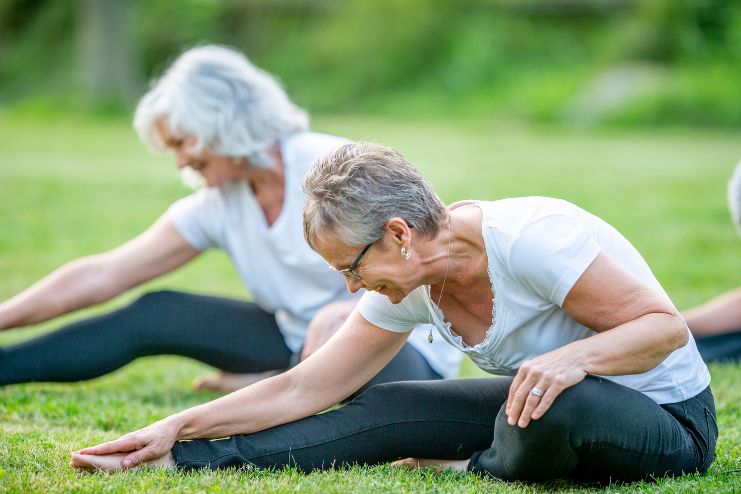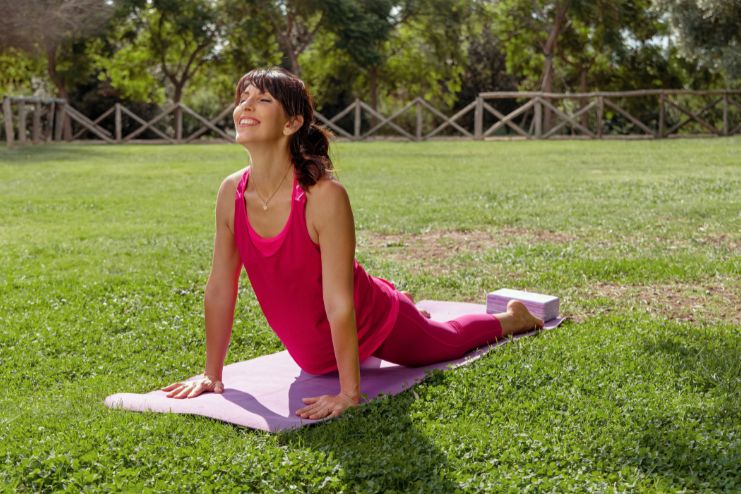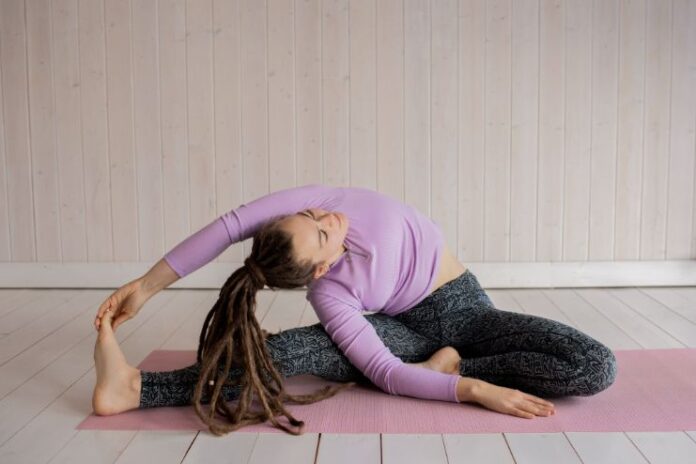Affiliate Disclaimer
Some links in this article are affiliate links. We may earn a small commission if you make a purchase through these links, at no extra cost to you. We only recommend products we find useful to our readersImagine waking up each day with the agility to embrace life’s adventures, free from stiff joints or limited mobility constraints. Flexibility, often overshadowed by strength and endurance training, is pivotal for our health and longevity. Beyond allowing us to touch our toes or execute a graceful yoga pose, flexibility is intricately linked to our body’s functionality and resilience against aging.
Recent research has shed light on the deep relationship between flexibility and lifespan. A study published in the Scandinavian Journal of Medicine & Science in Sports discovered that people with higher levels of flexibility were less likely to die of natural causes. This relationship highlights the value of preserving flexibility as an anchor of healthy aging.
As we age, our bodies naturally change in ways that can reduce flexibility. Muscles and tendons lose their elasticity, joints stiffen, and the water in our tissues reduces, causing decreased range of motion and maybe even pain. These changes can hinder everyday activity, impact posture, and increase the likelihood of injury.
By understanding these processes and actively taking measures to improve flexibility, we can overcome these effects and encourage a healthier, longer life.
Read More: Daily Stretching Exercises for Flexibility and Mobility
Understanding Flexibility and Its Role in Aging

New studies have emphasized the connection between flexibility and a long life. A research article indicated that people with greater flexibility scores had a lower chance of mortality due to natural causes.
Flexibility means the capability of our muscles and joints to move through their full range of movement. It is typically divided into two forms:
- Static Flexibility: This involves holding a stretch in a stationary position, extending a muscle to its furthest point and maintaining that position.
- Dynamic Flexibility: This refers to the ability to move muscles and joints through a complete range of motion while performing active movements.
Read More: Dynamic vs. Static Stretching: Master the Right Stretch at the Right Time
With growing age, several physiological changes can lead to reduced flexibility:
- Loss of Elasticity in Muscles and Tendons: Aging causes our muscles to lose elasticity and reduce flexibility, leading to stiffness.
- Joint Stiffness: The cartilage that cushions joints wears out over time, which results in stiffness and discomfort.
- Decreased Water Content in Tissues: As previously mentioned, aging causes the water content in soft tissues and intervertebral discs to decrease, leading to stiffness and reduced flexibility.
Read More: The Impact of Daily Stretching on Flexibility and Overall Well-Being
Key Benefits of Flexibility for a Longer, Healthier Life

Including flexibility exercises in your routine offers numerous benefits that support a longer, healthier life. Here’s how flexibility improves longevity:
- Reduced Risk of Falls: Flexible joints and muscles improve balance and coordination, and lower the risk of falls, particularly in the elderly.
- Prevention of Joint Pain and Injuries: Flexible tendons and muscles are less likely to suffer from strains and injuries, preventing forces from concentrating in one area and causing pain.
- Maintain Independence and Mobility with Age: Flexibility is crucial in maintaining mobility and independence as we age. Simple actions like standing up from a chair, tying one’s shoes, or grasping something need Maintaining flexibility avoids stiffness and mobility problems, helping you stay independent for a longer time.
- Easier Everyday Movements: Increased flexibility simplifies daily activities such as bending, reaching, and lifting. Whether you’re grocery shopping, cleaning, or gardening, being able to bend and move more flexibly helps prevent strain and stiffness, enabling you to get the job done more easily.
- Less Risk of Chronic Pain and Degenerative Joint Disease: Keeping the joints flexible prevents stiffness and uneven wear on joints, lowering the risk of chronic pain and degenerative joint diseases.
- Stress Reduction: Flexibility exercises like stretching and yoga involve mindfulness and deep breathing which can stimulate the parasympathetic nervous system and lead to relaxation, stress reduction, and better focus.
- Better Posture and Spinal Wellness: Flexibility in the muscles supporting the spine helps maintain correct alignment and posture, decreasing the chances of back pain.
- Improved Circulation and Muscle Recovery: Stretching enhances the flow of blood to muscles, which helps in recovery and lessens muscle soreness.
Read More: Best Stretching Exercise For Your Body
Best Practices to Improve and Maintain Flexibility

Maintaining and enhancing flexibility requires a blend of regular movement, specific exercises, and good self-care. Add the following tips to your daily routine to promote flexibility and mobility with age:
- Regular Stretching Routine: A consistent stretching routine ensures that muscles remain elastic and joints mobile. Include static stretches (15-30 seconds of holding position) and dynamic stretches (controlled movements through the full range of motion) to maximize flexibility.
- Yoga and Pilates: Both Yoga and Pilates focus on flowing movement and controlled stretching, enhancing flexibility, posture, and core strength. They are also useful for balance and stress relief.
- Foam Rolling and Self-Myofascial Release: Foam rolling is a useful way to reduce muscle tightness and enhance circulation. This process releases tension in fascia (connective tissue), easing stiffness and improving the efficiency of movement.
- Hydration and Nutrition: Proper hydration is essential to maintaining healthy muscles and joints. Water maintains the suppleness of connective tissues, and anti-inflammatory foods with high levels of omega-3s (such as salmon, walnuts, and flaxseeds) maintain joint flexibility and minimize stiffness.
- Strength Training: Strength training increases flexibility by maintaining joint stability and avoiding muscle imbalances. Strengthening muscles surrounding joints decreases the risk of injury and improves range of motion.
Conclusion

Flexibility is an essential aspect of overall well-being that plays a significant role in our capacity to carry out everyday tasks, retain independence, and even extend our lifespan. We can maintain and enhance our flexibility throughout life by including frequent stretching, practicing exercises such as yoga, proper hydration, and balanced nutrition. Adopting these habits improves physical health and leads to mental and emotional well-being, ensuring a dynamic and enriching life.
Flexibility is more than just a fitness goal; it’s a long-term investment in your health, vitality, and quality of life. Small daily efforts can bring significant benefits, allowing you to move freely and comfortably for years to come.
The best part? It’s never too late to start. Whether you’re in your 30s, 50s, or beyond, making flexibility a priority can transform your movement, posture, and overall well-being. Take that first step today, stretch a little, move a little, and commit to a lifestyle that supports a stronger, more agile you for years ahead.
References
- https://pubmed.ncbi.nlm.nih.gov/39165228/
- https://www.medicalnewstoday.com/articles/being-more-flexible-help-people-live-longer
- https://www.health.com/flexibility-mobility-longevity-8704734
- https://stretch22.com/how-your-flexibility-impacts-your-longevity/
- https://health.ucdavis.edu/blog/cultivating-health/how-to-improve-your-stretching-and-flexibility-for-better-health/2024/10
- https://www.betterhealth.vic.gov.au/pilates-health-benefits
- https://toneopfit.com/blogs/dynamic-stretching-vs-static-stretching
- https://www.medparkhospital.com/en-US/lifestyles/omega-3-health-benefits-of-nutrition
In this Article


















